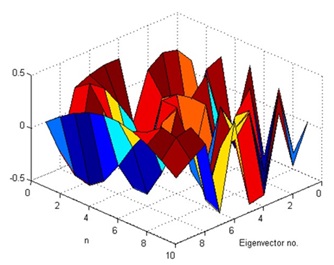Multirate Adaptive Equalization
Keywords:
adaptive, filter, ISI, multirate, equalizationAbstract
Finite Impulse Response (FIR) filter model emulates the Inter Symbol Interference (ISI) in a wireless communication channel. An equalizer, typically an Infinite Impulse Response (IIR) filter, behaves as an inverse filter to the FIR filter to remove the effects of the ISI. IIR filters are generally avoided due to tractability issues, and an FIR filter, with an adaptive signal processing algorithm to minimize the error due to the ISI, is deployed at the receiver. However, the filter is observed to quickly reach a steady state where further iterations do not yield a reduction in the error. This can be attributed to relatively slow variations in the steady state error which prevent further reduction of the errors. This work focuses on converting the low frequency error variations to high frequency variations by the use of multirate signal processing. As such, the steady state error can be damped as well, providing further reduction in the error and an enhanced adaptive filter performance.
References
T. S. Rappaport et al., “Wireless communications: principles and practice”. prentice hall PTR New Jersey, 1996, vol. 2.
B. Farhang-Boroujeny, “Adaptive filters: theory and applications” John Wiley & Sons, 2013.
M. Umer, “Adaptive lms based channel equalization,” International Journal of Technology and Research, vol. 2, no. 4, p. 111, 2014.
R. Martinek and J. Zˇ´ıdek, “The real implementation of nlms channel equalizer into the system of software defined radio,” 2012.
S. K. Sahoo and M. N. Mohanty, “Effect of ber performance in rls adaptive equalizer,” International Journal of Advanced Computer Research (IJACR), vol. 2, no. 4, 2012.
R. A. Fayadh, F. Malek, H. A. Fadhil, N. A. Al-Shareefi, H. Saad et al., “Mmse equalized rake-receiver using adaptive filter with a family of partial update algorithms in wireless communication systems,” International Journal of Engineering and Technology (IJET), vol. 5, no. 6, pp. 5169–5177, 2014.
R. Candido, M. Eisencraft, and M. T. Silva, “Channel equalization for synchronization of chaotic maps,” Digital Signal Processing, vol. 33, pp. 42–49, 2014.
R. N. Devi, T. Saikumar, and K. K. Rao, “Nlms algorithm based cma channel equalization through an adaptive mmse equalizer,” in Proceedings of the International Conference on Information Systems Design and Intelligent Applications 2012 (INDIA 2012) held in Visakhapatnam, India, January 2012. Springer, 2012, pp. 679–688.
Q. Chen, X.-P. Yang, D. Yang, and J. Ni, “Research progress of low-altitude wireless channel modeling and equalization techniques,” DianxunJishu/ Telecommunications Engineering, vol. 52, no. 1, pp. 117–124, 2012.
B. Alshehry, A. Odeh, and E. Abdelfattah, “Adaptive equalization: Lms, rls and cma,” 2014.
J. Ai, G. Yue, X. Cheng, and S. Li, “Low complexity rls channel estimation for sc-fde in 60 ghz communications,” in 2012 IEEE 14th International Conference on Communication Technology. IEEE, 2012, pp. 186–191.
S. Gilbert, “Computational science and engineering,” Massachusetts Institute of Technology, Wellesley-Cambridge Press, Massachusetts, USA, 2007.

Published
How to Cite
Issue
Section
License
Copyright (c) 2022 50Sea

This work is licensed under a Creative Commons Attribution 4.0 International License.




















